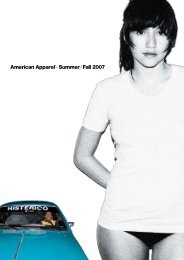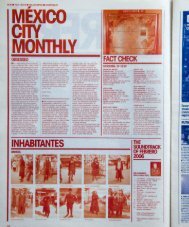MÉXICO CITY MONTHLY 2006 ... - American Apparel
MÉXICO CITY MONTHLY 2006 ... - American Apparel
MÉXICO CITY MONTHLY 2006 ... - American Apparel
Create successful ePaper yourself
Turn your PDF publications into a flip-book with our unique Google optimized e-Paper software.
mcm_may 4/25/06 5:08 PM Page 7<br />
on the recent trip– and a young gringo<br />
friend of his, Eddie Woods.<br />
Bill and Joan observed that the living<br />
room was full of empty gin, rum and<br />
soda pop bottles, but that everyone<br />
was sober. As it turned out, a party<br />
had taken place the previous evening<br />
with the <strong>American</strong> grantees of Mexico<br />
City College who had just received<br />
their monthly stipend and had spent<br />
the night getting drunk at the apartment.<br />
Joan and Burroughs served<br />
themselves a gin with lemonade and<br />
Healy left to attend to another matter.<br />
They continued drinking.<br />
Two and a half hours later –which<br />
means that neither Burroughs nor Joan<br />
were roaring drunk– the potential<br />
buyer had not arrived. Burroughs took<br />
out his Star 380 pistol, put it on the<br />
table and said he wanted to go live<br />
somewhere in South America and<br />
survive by hunting animals. Joan told<br />
him he would never dare shoot<br />
at anybody. Burroughs, who was<br />
an easy prey to female provocation,<br />
told her that in order to prove her<br />
wrong she should be kind enough<br />
to get up and put a glass half full<br />
of gin and lemonade on her head<br />
in order to perform their renowned<br />
William Tell act (it seems this was<br />
not the first time they had done it).<br />
Joan got up instantly, put the glass<br />
on top of her head and closing her<br />
eyes pronounced her last words:<br />
“I do not dare look, I cannot stand<br />
to see blood”.<br />
Burroughs got up as well, stood<br />
three meters away from her, extended<br />
his arm and shot.<br />
Joan fell to the floor like a punching<br />
bag detached from its hook. The bewildered<br />
spectators thought it was joke.<br />
Moments later, as they saw the red<br />
stream flowing on the floor and heard<br />
the strange noises coming out of Joan’s<br />
half-open mouth, they finally understood<br />
what had happened.<br />
Marker ran out of the apartment<br />
to look for the medical student who<br />
lived next door, and Burroughs knelt<br />
next to Joan’s body and yelled:<br />
"Speak to me! Speak to me!"<br />
Woods left Burroughs screaming and<br />
went to look for the concierge, who<br />
called an ambulance, the police and<br />
Burroughs's attorney, Bernabé Jurado.<br />
The ambulance arrived at the apartment<br />
at 7:30 p.m. and took the body<br />
of dying Joan; Burroughs accompanied<br />
her to the Red Cross at Durango and<br />
Sonora Streets. Joan died an hour<br />
later. When Burroughs was told,<br />
he cried, heartbroken, pulling his hair<br />
in impotence. His famous,and skillful<br />
gangster-lawyer, Bernabé Jurado,<br />
immediately reached him at the hospital<br />
together with the police, who took<br />
Burroughs first to the Eighth District<br />
(Cuauhtémoc Avenue at Obrero<br />
Mundial) and later to Lecumberri<br />
Prison, known as the Black Palace.<br />
In his first declaration to the police,<br />
Burroughs was faithful to the actual<br />
events: he and Joan had decided<br />
to play William Tell, and instead<br />
of hitting the glass, the bullet pierced<br />
Joan’s temple. It was an accident,<br />
he affirmed. But when Bernabé Jurado<br />
met Burroughs later on, he asked him<br />
to change his declaration and say that<br />
his pistol went off by mistake when<br />
it fell on the floor, and stop mentioning<br />
the William Tell act. Burroughs obeyed.<br />
Jurado then started to pull some<br />
strings and bribed the investigators<br />
with Mortimer Burroughs’s money<br />
–William’s brother who immediately<br />
came to Mexico–. Jurado told Burroughs<br />
exactly what to do and say and after<br />
13 days the famous writer left jail<br />
on bail. Burroughs blessed the<br />
corrupt Mexican courts.<br />
All the police sections of the newspapers<br />
back then repeated the story<br />
of William Tell, publishing lies,<br />
sensationalism and false declarations.<br />
Burroughs’s elder brother Mortimer<br />
buried Joan at the <strong>American</strong> Cemetery<br />
in Tacuba and the children, who had<br />
stayed several days at Orizaba #210<br />
with the terrified neighbors, who did<br />
not know what to do with them,<br />
returned to the United States to live<br />
with their grandparents. Burroughs’s<br />
stay in Lecumberri Prison was brief<br />
and not terrible at all. The inmates<br />
treated him well and even gave him<br />
blankets so he would not be cold at night.<br />
Once freed on bail, Burroughs was<br />
obliged to stay in Mexico until his<br />
case was closed. But since the notoriously<br />
incompetent Mexican authorities<br />
did not solve anything after a year<br />
and three months, Burroughs easily<br />
foiled them and escaped illegally from<br />
Mexico, never to return.<br />
He went to South America again,<br />
where he finally tried yagé, which<br />
revealed, according to him, great<br />
truths. Later, he traveled to Tangier,<br />
Morocco, where he lived for six years,<br />
and after experiencing a sort of hell<br />
due to his opiate addiction, he wrote<br />
the book that would make him<br />
famous: Naked Lunch.<br />
After a 25-year silence, Burroughs<br />
decided to talk about Joan’s death.<br />
In 1985, he wrote that on that fateful<br />
afternoon in 1951, an evil spirit<br />
possessed him and ordered him<br />
to kill Joan. From then on, the only<br />
way he could resist it was by writing.<br />
Becoming a writer was, according<br />
to him, the only safe-conduct that<br />
allowed him, since then, to neutralize<br />
and calm the evil force that killed<br />
his wife.<br />
JACK KEROUAC IN THE HOT LAND<br />
OF DESERT RATS AND TEQUILA.<br />
When Burroughs had just arrived<br />
in Mexico City, in September 1949 he<br />
sent a letter to a friend eight years his<br />
junior, telling him of the marvels of the<br />
place: "Mexico is very cheap, there are<br />
fabulous brothels and restaurants.<br />
Cockfights, bullfights, all kinds<br />
of entertainments; you must visit me".<br />
Seduced by such praise, a few<br />
months later, in June 1950, Jack<br />
Kerouac, his hero-friend Neal Cassady<br />
and Frank Jeffries, another friend, took<br />
off in Neal’s 1937 Ford and drove<br />
straight from Denver, Colorado to Laredo,<br />
Texas. They crossed the Mexican-<br />
<strong>American</strong> border and when they arrived<br />
in Gregoria, Tamaulipas, they immediately<br />
smoked some marihuana and<br />
went into a joint where they went on<br />
to spend an awesome night with<br />
northern whores, gallons of alcohol<br />
and mambo dancing.<br />
The next day, Kerouac and friends,<br />
with Neal at the steering wheel,<br />
entered Mexico City, immediately<br />
visiting Burroughs at his house<br />
in Colonia Roma. Neal and Frank<br />
soon went back to the States and Jack<br />
was left alone with Burroughs, who<br />
took him out to bars and restaurants<br />
in Colonia Roma and occasionally<br />
partook in smoking pot with him<br />
–Jack preferred alcohol and cannabis<br />
to opiates. One day they both went<br />
to the bullfights at Plaza Mexico, and<br />
while Burroughs enjoyed the “bloody<br />
show”, Jack was horrified. Besides<br />
that, Kerouac, unlike Burroughs,<br />
frequented prostitutes at Órgano Street<br />
in Peralvillo, the city's official red light<br />
district. Three months later, Kerouac<br />
went back to New York.<br />
IN LOVE WITH A MEXICAN JUNKIE<br />
Four years later, in 1955, Kerouac, still<br />
an unknown writer, went to Mexico<br />
City once more and arrived at the tiny<br />
building at Orizaba #210 in Colonia<br />
Roma, Burroughs’s last address. There<br />
lived an <strong>American</strong> junkie friend of<br />
theirs by the name of Bill Garver;<br />
all day, he would inject into his veins<br />
any opium derivative he could find.<br />
In that place, Jack wrote one of his<br />
most recognized books of poetry,<br />
México City Blues. He also met a drugfriend<br />
of Garver’s, a 25-year-old<br />
morphine addicted prostitute by the<br />
William Burroughs en la prisión del palacio de Lecumberri. Ciudad de México, 1951.<br />
William Burroughs in Lecumberri’s Palace prision. Mexico City, 1951.<br />
name of Esperanza Villanueva, with<br />
whom he fell in love and who served<br />
as the model for his only completely<br />
Mexican Beat novel, Tristessa.<br />
For Kerouac, who considered himself<br />
a Buddhist at the time, Esperanza-<br />
Tristessa, a faithful believer in the<br />
Virgin of Guadalupe, who never<br />
missed the Sunday mass, was a kind<br />
of saint who augmented her religious<br />
aura by prostituting and drugging<br />
herself. With her, he got to know<br />
Mexico City’s lowlife, Garibaldi and<br />
the outskirts of downtown. He ate<br />
greasy tidbits from street carts at late<br />
hours, saw hotels swarming with prostitutes<br />
and drug addicts, met scumbags<br />
who robbed him of his poetry<br />
notebooks and humiliated him,<br />
and did not defend himself or respond<br />
at all (whereas Burroughs would<br />
have scared them with bullets).<br />
Esperanza did not return the affection<br />
that Jack felt for her. She preferred<br />
getting stoned to falling in love, and<br />
rejected the gringo poet’s advances.<br />
He was probably more interested<br />
in her as a fascinating subject for<br />
his novel than as a desirable mate;<br />
nonetheless, he continued to help<br />
Garver and Esperanza get drugs from<br />
Chinese laundries and corrupt drugstores.<br />
Once, when they had no drugs,<br />
Esperanza started raging, breaking,<br />
slamming and throwing all types<br />
of things onto the floor in Garver’s<br />
apartment, then she threw herself<br />
on the floor and started shaking,<br />
kicking and shouting outrageously.<br />
She accused Jack of being a repulsive<br />
drug addict and threw a bottle<br />
in his face.<br />
Another time when Jack again<br />
declared his love to her in a taxi,<br />
Esperanza turned away indifferently<br />
and did not answer. When they arrived<br />
at Garver’s house, he told Jack: "If you<br />
put Grace Kelly on one chair and dirty<br />
morphine on the other, my dear Jack,<br />
I would choose the morphine."<br />
Esperanza, who was listening,<br />
said: “I also do not want love”.<br />
Kerouac understood the message<br />
and did not see her again.<br />
A year later, in October 1956, while<br />
Jack was writing the last part of<br />
Tristessa, two of the most important<br />
and recognized Beat poets, Allen<br />
Ginsberg and Gregory Corso, came<br />
to visit him, accompanied by Peter<br />
Orlowsky, Ginsberg’s lover. Kerouac<br />
took them to the Pyramids of<br />
Teotihuacán and when they reached<br />
the top of the Sun Pyramid, they<br />
smoked a joint in order to connect<br />
with the mystic energy of the site.<br />
On another occasion, they went<br />
to the Bombay club (which still exists)<br />
in Garibaldi, "the slum's slummiest<br />
hole agitating mud from our lips."<br />
They left the place and went to a street<br />
corner full of prostitutes "standing<br />
ranked against pockholed walls full<br />
of bedbugs and cockroaches." Peter<br />
and Jack decided to take a whore<br />
to bed, Ginsberg waited outside and<br />
Corso, disgusted, went home. Kerouac<br />
chose a girl of 14 and Orlowsky a fat<br />
middle-aged woman. The minor turned<br />
out to be "so small you can't find her<br />
for at least a minute of probing."<br />
Peter finished with the fat lady, who<br />
apart from pleasure gave him gonorrhea,<br />
which he cured with penicillin.<br />
The last thing they did before returning<br />
to the States was to go up to the top of<br />
the bell tower of the Metropolitan<br />
Cathedral and sound the bells as if<br />
“to call the Mexican people to a poetic<br />
insurrection”. Nobody paid any attention.<br />
Jack Kerouac visited Mexico twice<br />
again. Once in 1957, just when the<br />
FEATURE ■ MCM<br />
great earthquake brought the Angel<br />
of Independence to the ground.<br />
He was in his hotel at the moment<br />
and wrote: "The hotel room is rocking<br />
like a ship and I’m under the bed<br />
to protect myself against falling ceilings.<br />
The entire apartment building across<br />
the street from the post office on<br />
Obregón Street is falling and killing<br />
everybody".The truth is that the earthquake<br />
only killed 70 people.<br />
The last time Kerouac visited Mexico,<br />
now as an important and famous writer,<br />
was in June 1961; and as on his first<br />
visit, eleven years earlier, he arrived<br />
at the apartment on Cerrada de Medellín<br />
35, closing the circle of his travels<br />
to the southern country. The only thing<br />
that happened to him on that trip, apart<br />
from writing a few texts, was that<br />
several young Mexicans from Colonia<br />
Roma, who clearly did not know<br />
he was a writer, invited him for a few<br />
drinks at their house, then stole his razor<br />
blade, his Buddhist rosary, his flashlight,<br />
his bag, and when they were about to<br />
take his overcoat, Jack implored them<br />
to leave it since it was a present from<br />
his mother. The guys just laughed and<br />
took it all. Jack never returned to<br />
“the hot land of desert rats and tequila”,<br />
as he called Mexico. He died of alcohol<br />
congestion eight years later. He was<br />
47 years old and already an icon of<br />
the counterculture youth of the Sixties.<br />
El autor y William Burroughs practican su puntería en Lawrence, Kansas, EEUU.<br />
The author and William Burroughs target-shooting in Lawrence, Kansas, USA.<br />
Siete







